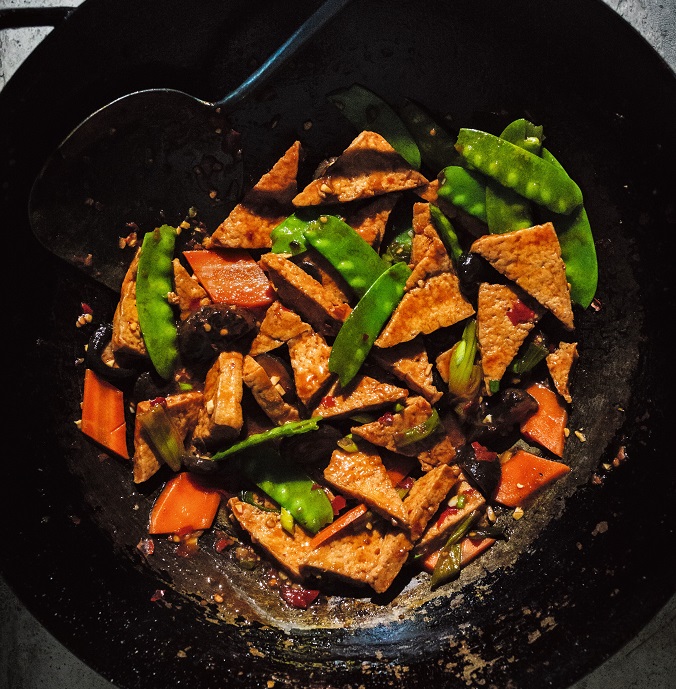Chef Hannah Che shared her recipe for Homestyle Braised Tofu from her book, The Vegan Chinese Kitchen – Modern Recipes and Stories from a Thousand-Year-Old Tradition.

Homestyle Braised Tofu
Serves 4 to 6
– 3 large dried shiitake mushrooms, or ¼ ounce (7 grams) dried wood ear mushrooms
– Boiling water
– Kosher salt
– 14 to 16 ounces (390 to 450 grams) medium-firm tofu, cut into ½-inch-thick slices
– ½ teaspoon potato starch or cornstarch
– Vegetable oil, for frying
– 1 tablespoon finely chopped garlic
– 1 tablespoon finely chopped fresh ginger
– 2 scallions, white parts cut into1-inch segments, green parts thinly sliced and reserved for garnish
– 1½ tablespoons Sichuan chili bean paste
– 1teaspoon soy sauce
– 1¼ cups (300 mL) unsalted stock of any kind or water
– ½ teaspoon sugar
– ½ cup thinly sliced (¼-inch) carrot (cut into semicircles or diamonds)
– ½ cup snow peas or green pepper, cut to match the carrot
Directions:
In a small bowl, soak the shiitake mushrooms in boiling water for 30 minutes. Drain, snip off and discard the stems, and halve the caps. In a wok or saucepan, bring a few cups of generously salted water to a boil. Add the tofu slices and let soak for 3 to 5 minutes, then remove and blot dry with a clean tea towel.
Combine the starch with 1 tablespoon of cold water in a small bowl. Heat ½ cup oil in a wok or skillet, or enough to cover the pan’s bottom by about ½ inch. When the oil is hot and shimmering, slide in as many tofu pieces as will fit in a single layer on the surface. Don’t move the tofu until a golden crust develops on one side, about 4 minutes. Flip and cook on the other side for about 3 minutes, transfer to a paper towel-lined plate, and repeat until all the tofu is golden brown, crispy, and slightly puffy. Transfer the frying oil to a heatproof container for another use, reserving 1 tablespoon in the wok.
Return the wok to medium-high heat. Stir-fry the shiitake mushrooms, garlic, ginger, and scallion whites until fragrant, about 2 minutes. Push the aromatics to one side of the wok, then add the chilli bean paste and stir-fry briefly to release its flavour. Add the soy sauce, stock, and sugar. When the liquid is bubbling, add the fried tofu and carrot. Cover the wok and cook gently for 3 to 4 minutes to allow the tofu to absorb the flavours.
Uncover and add the snow peas. Return the heat to high and cook, stirring, until the liquid has reduced. Taste and adjust the flavours, adding more salt as needed. Give the starch slurry a stir and add it gradually to the wok, stirring continuously for 30 seconds, until the sauce is lightly thickened and clings to the tofu. Remove from the heat and stir in the scallion greens. Transfer to a dish and serve.
***

The Vegan Chinese Kitchen – Modern Recipes and Stories from a Thousand-Year-Old Tradition, By Hannah Che. Featuring over 100+ fresh, plant-based, umami-packed recipes for regional Chinese classics we all know and love.
Hannah Che is a cook, writer, and photographer based in Oregon, USA. Born and raised in Detroit, Michigan, she lived in China for several years with her family and most recently spent a year travelling throughout China and training as a chef at the Guangzhou Vegetarian Culinary School. She is the creator of the blog The Plant-Based Wok.
When Hannah Che decided to become a vegan, she was concerned that it would alienate her from the traditions and food that her Chinese family celebrated. But that was before she learned about Zhai cai, or vegetarian cooking, a fascinating subset of Chinese cookery that emphasizes umami-rich ingredients and can be traced back over hundreds, if not a thousand, years to Buddhist temple kitchens.
In The Vegan Chinese Kitchen, Hannah Che shows us the magic of the highly developed and creative tradition in which nearly every dish in the Chinese repertoire can be replicated in a meatless way, such as Blistered Dry-Fried String Beans, Sweet and Sour Tofu, Sichuan chilli-oil wontons, or using spicy mushrooms in dan-dan Noodles. As a graduate of the prestigious Guangzhou Vegetarian Culinary School – the only culinary institute in China dedicated to traditional vegetarian cooking – Hannah brings a strong sense of authenticity to the subject of plant-based Chinese cuisine.
In the book, readers will find recipes that are naturally plant-based with a rich culinary history that are as irresistible as they are nourishing. The Vegan Chinese Kitchen will delight vegans and omnivores alike, inviting them not only to explore a whole new world of flavours and ingredients, but also to create conversations about food, cultural traditions and identity, and wholesome, sustainable cooking.




